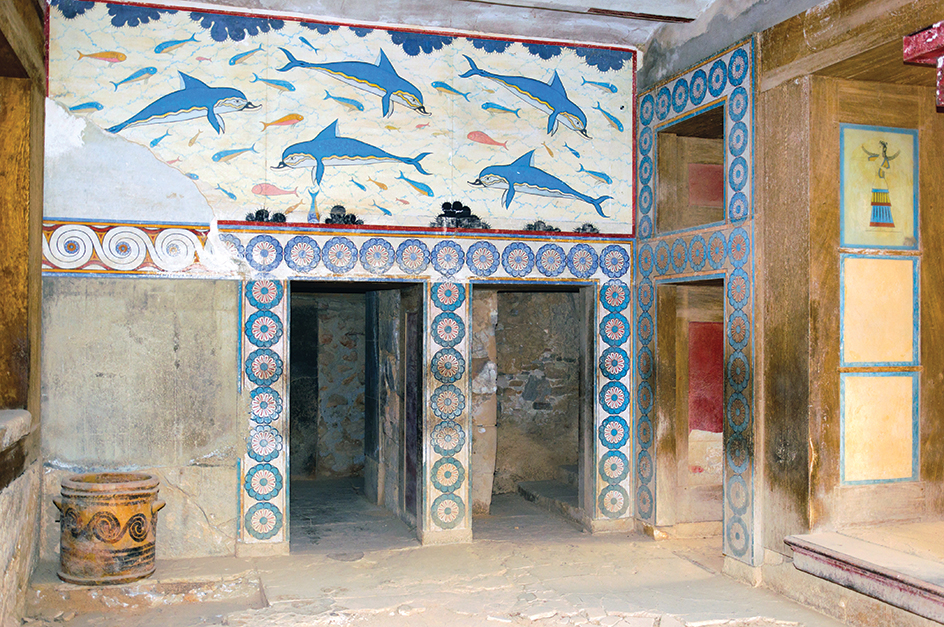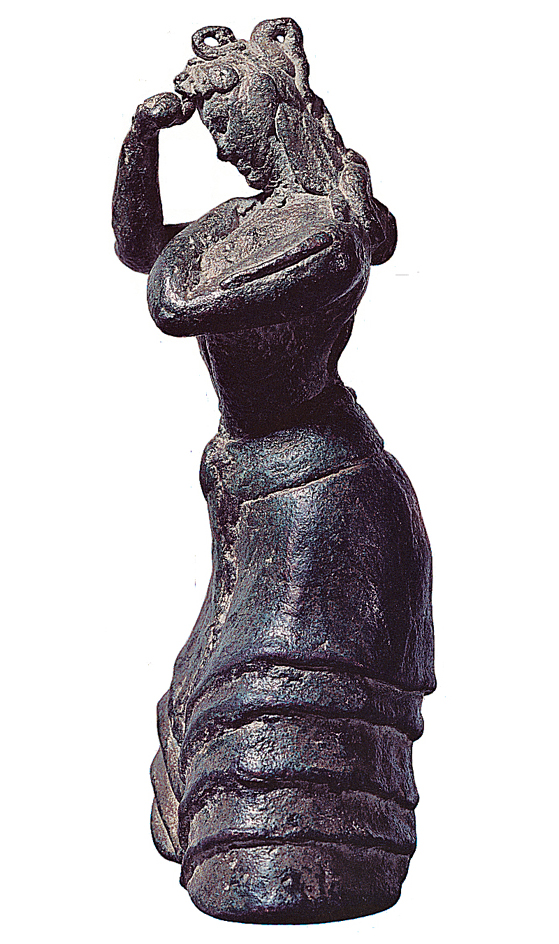Aegean, << ih JEE uhn, >> civilization consisted of four cultures that flourished on the islands and shores of the Aegean Sea between about 3000 and 1100 B.C. These cultures are called the Cycladic, Minoan, Mycenaean, and western Anatolian cultures. The Cycladic culture developed on a group of islands called the Cyclades. The Minoan culture arose on the island of Crete, and the Mycenaean culture flourished on the mainland of Greece. The city of Troy, in the northwestern part of ancient Anatolia (now Turkey), was a center of western Anatolian culture.

The Aegean civilization arose after the people of the area discovered how to make bronze. During this period, called the Aegean Bronze Age, the people became highly skilled in architecture, painting, and various crafts. They built richly decorated palaces and used systems of writing. The Aegean Bronze Age ranks as one of the greatest artistic and cultural ages in history.

The Aegean civilization collapsed around 1100 B.C. The craftwork skills, the systems of writing, and the building knowledge were lost, and most trade ended. The region was relatively isolated from other parts of the Mediterranean world during the next 300 years.
The Aegean people left no written history. However, their descendants told stories about gods, great kings and heroes, and bloody wars. Some of these stories may have been based on actual people and events. The tales formed the basis for the epics the Iliad and the Odyssey, attributed to the Greek poet Homer. The Aegean people also kept some records written on clay tablets. These records were written in characters that were deciphered as an early form of Greek in A.D. 1953.
Archaeologists have uncovered most of the information known about the Aegean civilization. In the 1870’s, the German archaeologist Heinrich Schliemann began research on the civilization. He believed that many stories in classical Greek literature were based on real events, and he searched for the sites of legendary cities. In 1870, using legends as a guide, Schliemann conducted the first major excavation on the site of Troy. In 1876, he launched the study of the Mycenaean culture. Schliemann discovered royal graves in Mycenae on the Greek mainland.
In the late 1800’s, James T. Bent, a British scholar, and Christos Tsountas, a Greek archaeologist, explored the Cycladic culture. In 1900, Arthur Evans, another British scholar, began excavating the Palace of Minos in Knossos on the island of Crete. His research provided much of the present-day knowledge of the Minoan culture.

The Cycladic culture
flourished on a number of Aegean islands, including Milos, Naxos, Siros, and Thira. Many Cycladic people made their living by fishing. Others worked as sailors and traders. Still others were farmers, many of whom grew grapes for use in producing wine. Cycladic craftworkers made distinctively designed pottery and stone figurines. After 1900 B.C., the Cycladic culture declined and adopted many features of the Minoan and Mycenaean cultures.
The Minoan culture,
which arose on Crete, was named for Minos, the legendary king of the island. According to tradition, Minos ruled the Aegean Sea and kept the Minotaur, a monster that was half man and half bull. See Minos ; Minotaur .
The Minoans were skilled artists and architects and active traders. They built the Palace of Minos in Knossos, as well as palaces in Zakros, Mallia, Galatas, and Phaistos. The Minoans traded throughout the Aegean region and in Egypt. Other people of the Aegean area copied Minoan designs in pottery and other craftwork. The Minoans developed a decimal system and used a writing system in which complex symbols represented syllables of words. The Mycenaeans on the mainland of Greece later adapted the Minoan writing system to their language.
After about 1450 B.C., fire destroyed nearly all the towns and palaces on Crete. Although it was damaged, the palace in Knossos survived and Mycenaeans gained control of it. The Mycenaeans finally abandoned the palace in the early 1300’s B.C. Minoan culture began to decline after the palace was lost. The culture disappeared about 1100 B.C.

The Mycenaean culture,
also called the Helladic culture, centered on Mycenae, a powerful city on the mainland of Greece. By about 2000 B.C., a group of people had moved to the Peloponnesus, the southern peninsula of Greece, and had established Mycenae. Archaeologists do not know where these people came from. The people introduced new styles of pottery to the area and built houses that had a large central room. Scholars believe the Mycenaeans may have spoken a dialect that later developed into the Greek language.
By the 1500’s B.C., the Mycenaeans had grown rich and powerful, and they greatly influenced Aegean culture. For this reason, archaeologists call the late Bronze Age in Greece the Mycenaean period. The Mycenaeans used Minoan architecture as a model for their palaces. During the 1300’s B.C., they built palaces in Mycenae and in such places as Athens, Pylos, Thebes, and Tiryns. The palace in Mycenae was surrounded by massive walls with a huge gateway called the Lion Gate.
By about 1200 B.C., the Mycenaean civilization had collapsed, and its main centers had been destroyed. Scholars do not know whether the civilization fell because of internal disorder or under attack from invaders. According to one traditional account, the Mycenaeans were invaded by the Dorians, a people from northwestern Greece. But many experts now believe the Dorians did not actually exist.
Anatolian culture.
The city of Troy was one center of western Anatolian culture. The people of Troy are known as Trojans. Archaeologists have uncovered the remains of nine cities on the site of Troy. Each successive city was built on the ruins of the one before it. Archaeologists believe the seventh city was the legendary Troy described in the Iliad and the Odyssey. This city was built in the mid-1200’s B.C. It was set afire and destroyed around 1200 B.C., possibly by invaders from the mainland of Greece.
